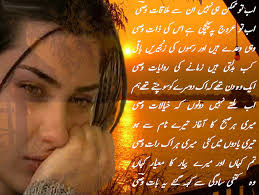Urdu Poetry With Pictures Biography
Source (google.com.pk)
Urdu poetry (Urdu: اُردُو شاعرى Urdū S̱ẖāʿirī) is a rich tradition of poetry and has many different forms which have basically originated from Arabic and from Persian language. Today, it is an important part of the cultures of Pakistan and India. Literary figures as far back as Amir Khusro (1253-1325 CE) and Kabir (1440–1518 CE) inspired later Urdu poets, and served as intellectual and linguistic sources. Meer, Dard, Ghalib, Anees, Dabeer, Iqbal, Zauq, Josh, Jigar, Faiz, Firaq, Ahmad Nadeem Qasmi, Shair, Mohsin and Faraz are among the greatest poets of Urdu. The tradition is centered in the South Asia. Following the Partition of India in 1947, it found major poets and scholars residing primarily in modern Pakistan. Mushairas (or poetic expositions) are today held in metropolitan areas worldwide.
The principal forms of Urdu poetry are:
Ghazal, is a set of two liner couplets, which strictly should end with the same rhyme and should be within one of the predefined meters of Ghazals.There has to be minimum of five couplets to form a Ghazal. Couplets may or may not have same thought. It is one of the most difficult forms of poetry as there are many strict parameters that one needs to abide by while writing Ghazal.
Hamd is a poem in praise of Allah. The word "hamd" is derived from the Qur'an, its English translation is "Praise".
Marsiya (or elegy), is nearly always on the death of Hasan and Husain and their families, but occasionally on the death of relatives and friends. It is usually in six-lined stanzas with the rhyme aaaabb. The recitation of these elegies in the first ten days of Muharram is one of the greatest event in Muslim life. A fully developed marsiya is always an epic. The famous marsia writers who inherited the tradition of Mir Anis among his successive generations are Mir Nawab Ali 'Munis', Dulaha Sahab 'Uruj', Mustafa Meerza urf Piyare Sahab 'Rasheed', Syed Muhammad Mirza Uns, Ali Nawab 'Qadeem', Syed Sajjad Hussain "Shadeed" Lucknavi, Allama, Dr.Syed Ali Imam Zaidi, "Gauher" Luckhnavi the(great grandson of Mir Babber Ali Anis).
Masnavi, in the majority of cases a poetic romance. It may extend to several thousand lines, but generally is much shorter. A few masnavis deal with ordinary domestic and other occurrences. Mir and Sauda wrote some of this kind. They are always in heroic couplets, and the common metre is bacchic tetrameter with an iambus for last foot. The Religious masnavi History of Islam (Tarikh-e-Islam Az Quran) written by Dr. Syed Ali Imam Zaidi Gauher Lucknavi.
Naat is a poetry that specifically praises the Islamic prophet Muhammad.
Nazm Urdu nazm is a major part of Urdu poetry. From Nazeer Akarabadi, Iqbal, Josh, Firaq, Akhtarul Iman to down the line Noon Meem Rashid, Faiz, Ali Sardar Jafri and Kaifi Azmi. They have covered common life, philosophical thinking, national issues and the precarious predecament of individual human being.As a distinct form of Nazm many Urdu poets influenced by English and other European poets took to writing sonnets in Urdu language. Azmatullah Khan (1887-1923) is believed to have introduced this format to Urdu Literature. The other renowned Urdu poets who wrote sonnets were Akhtar Junagarhi, Akhtar Sheerani, Noon Meem Rashid, Zia Fatehabadi, Salaam Machhalishahari and Wazir Agha.
Qasida, a kind of ode, often panegyric on a benefactor, sometimes a satire, sometimes a poem dealing with an important event. As a rule it is longer than ghazal, but it follows the same system of rhyme.
Qawwali, is a form of Urdu poetry read along with devotional music, A Qawwali is almost always dedicated to particular Sufi.
Shayari, a beautiful musical form of Urdu poetry allows a person to express the deepest feelings through words. It lets you explain sentiments in all their forms through rhythmic words.
Ruba'i, is a poetry style, the Arabic term for "quatrain". The plural form of the word, rubāʿiyāt, often anglicised rubaiyat, is used to describe a collection of such quatrains.
Tazkira, biographical anthology, almost always of poetry alone. This is often a mere collection of names with a line or two of information about each poet, followed by specimen of his composition. On the other hand it may be the history of Urdu poetry with copious illustrative extracts. The best tazkiras give biographical details, but fail in literary criticism, and we get little idea of style or poetical power, still less of contents of poems. Even the large anthologies do not systematically review an author's work. Most of them have the names in alphabetical order, but one or two prefer historical order. The majority quote only lyrics, and the quotations, usually chosen at random, do not illustrate poetry.
Collection forms of Urdu poetry
The principal collection forms of Urdu poetry are:
Diwan, a collection of poems, chiefly gazals.
Kulliyat, literally a complete collection of poems, but often applied to any collection containing poems of various kinds. Thus, Akbar Allahabadi published three kulliyats.
In Pakistan, Urdu poetry is written in the standard Nasta'liq calligraphy style of the Perso-Arabic script. However, in India, where Urdu poetry is very popular, the Perso-Arabic is often found transliterated into the Devanāgarī script, as an aid for those Hindī-speakers, who can comprehend Urdu, but cannot read the Perso-Arabic script. With the dawn of the internet and globalisation, this poetry is often found written in Roman Urdu today.
Urdu Poetry With Pictures
.jpg)
.jpg)
Urdu Poetry With Pictures

Urdu Poetry With Pictures

Urdu Poetry With Pictures

Urdu Poetry With Pictures

Urdu Poetry With Pictures

Urdu Poetry With Pictures


Urdu Poetry With Pictures
.jpg)
.jpg)
Urdu Poetry With Pictures

Urdu Poetry With Pictures

Urdu Poetry With Pictures
No comments:
Post a Comment